1. Introduction
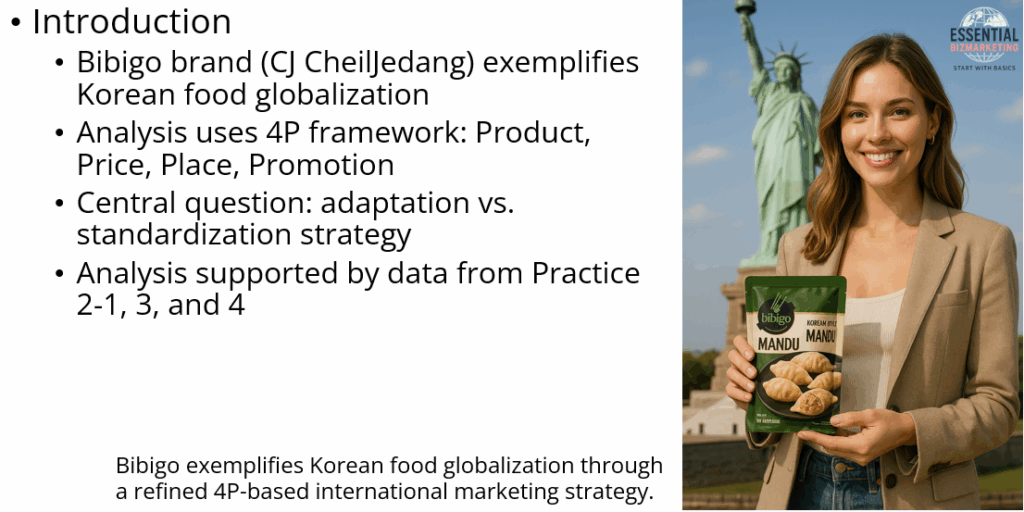
CJ CheilJedang’s Bibigo brand has become a flagship example of Korean food globalization, driven by a nuanced international marketing strategy. This report analyzes Bibigo’s global marketing using the 4P framework—Product, Price, Place, and Promotion—anchored in the central question of adaptation versus standardization as discussed in Chapter 14 of Developing and Marketing Products. Supporting data from Practice 2-1, Practice 3, and Practice 4 provide further context and depth to the analysis.
2. Product Strategy: Adaptation with Strategic Consistency
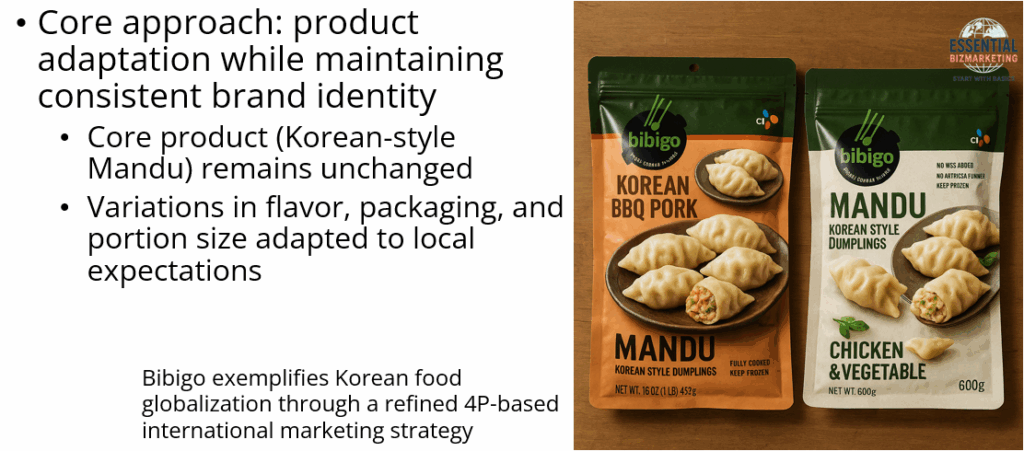
Bibigo has opted for a product adaptation strategy while maintaining a consistent brand identity across borders. While the core product—Korean-style dumplings (Mandu)—remains the same, variations in flavor, packaging, and portion size are made to align with local cultural expectations.

As illustrated in Practice 2-1, Bibigo adapts its product line to reflect regional consumer behaviors. In the U.S., smaller packs and microwave-ready options cater to individualistic lifestyles and convenience-driven habits. In contrast, Chinese and Southeast Asian markets prefer bulk packaging aligned with collectivist, family-style consumption. Japanese consumers, who emphasize precision and aesthetics, respond to high-quality packaging and refined flavor profiles.
Chapter 14 emphasizes that adaptation becomes necessary when legal, cultural, or perceptual differences exist between markets. Bibigo demonstrates that adaptation, when built upon a standardized core product identity, can achieve both global coherence and local relevance.
3. Price Strategy: Market-Specific Dual Pricing
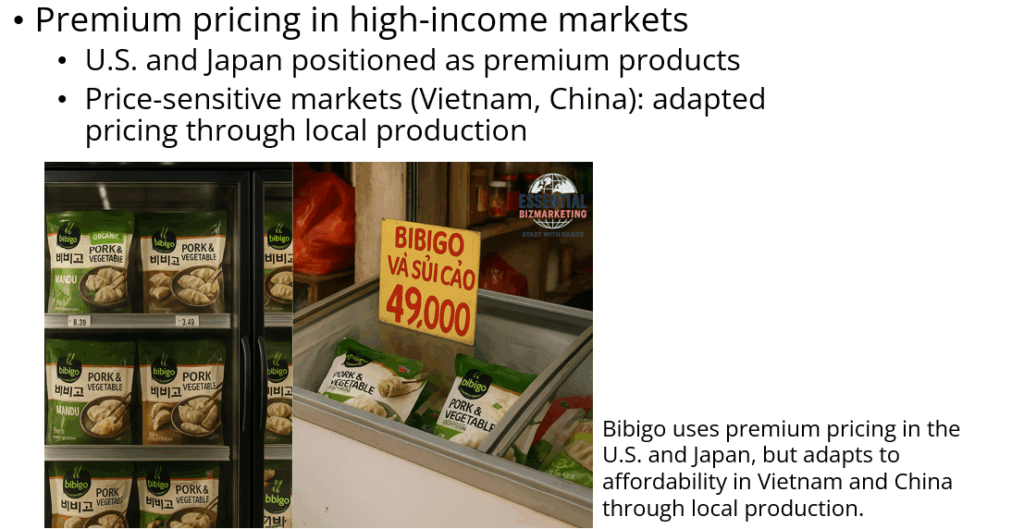
Pricing is a critical area where Bibigo applies a dual strategy. In high-income, premium-focused markets such as the United States and Japan, Bibigo maintains a premium price positioning. Meanwhile, in price-sensitive markets like Vietnam and China, it adapts pricing to match local affordability levels—often through local production or OEM strategies.

Practice 4 outlines the economic conditions that necessitate such differentiation. High labor costs in markets like the U.S. and the EU make local production costly, justifying premium pricing. Conversely, Bibigo’s operations in lower-cost regions allow for competitive pricing without undermining brand value.
Chapter 14 describes dual pricing as a common solution to the challenges posed by varying production costs, purchasing power, and trade-related expenses. Bibigo’s approach—balancing local production, logistics costs, and purchasing power—reflects a strategic response to these challenges.
4. Place Strategy: Distribution Aligned with Infrastructure and Cost Efficiency

Bibigo’s distribution strategy varies based on each country’s retail landscape and infrastructure development. In countries with well-developed logistics systems—such as the U.S., Japan, and EU nations—Bibigo relies on intensive distribution through major retail chains and e-commerce platforms.
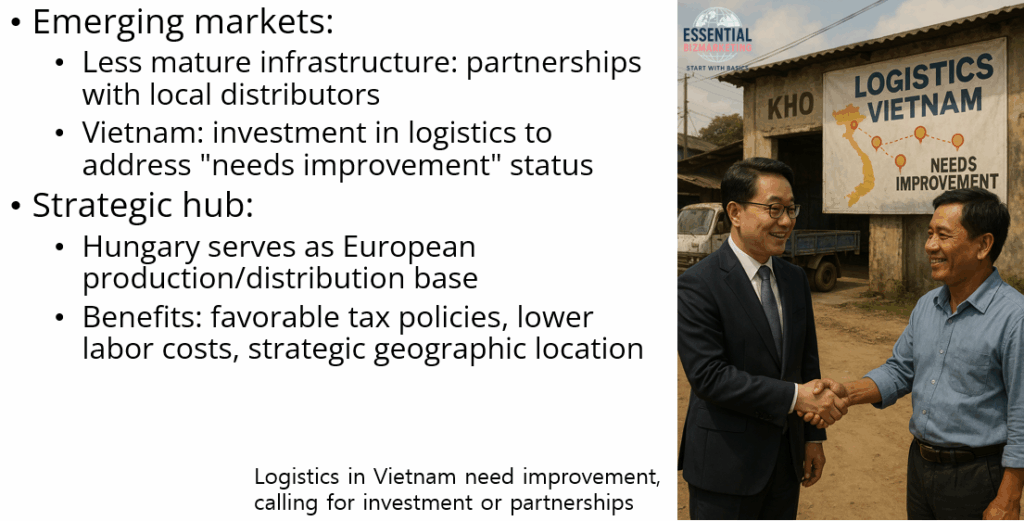
In emerging markets with less mature infrastructure, Bibigo partners with local distributors to improve reach and reliability.
Practice 4 confirms that countries like Japan and the U.S. offer “excellent” logistics systems, enabling high service quality through centralized imports. Meanwhile, markets like Vietnam, with “needs improvement” in logistics, require investment or partnership-based solutions.
Additionally, Practice 3 provides insight into Bibigo’s choice of Hungary as a regional production and distribution base for Europe. Hungary’s favorable tax policies, lower labor costs, and strategic geographic location make it a cost-effective distribution hub within the EU.
Chapter 14 emphasizes the importance of adapting distribution channels to local conditions while leveraging economies of scale when possible. Bibigo exemplifies this principle by aligning its logistics decisions with infrastructure quality and cost structures.
5. Promotion Strategy: Communication Adaptation Anchored in Cultural Insight
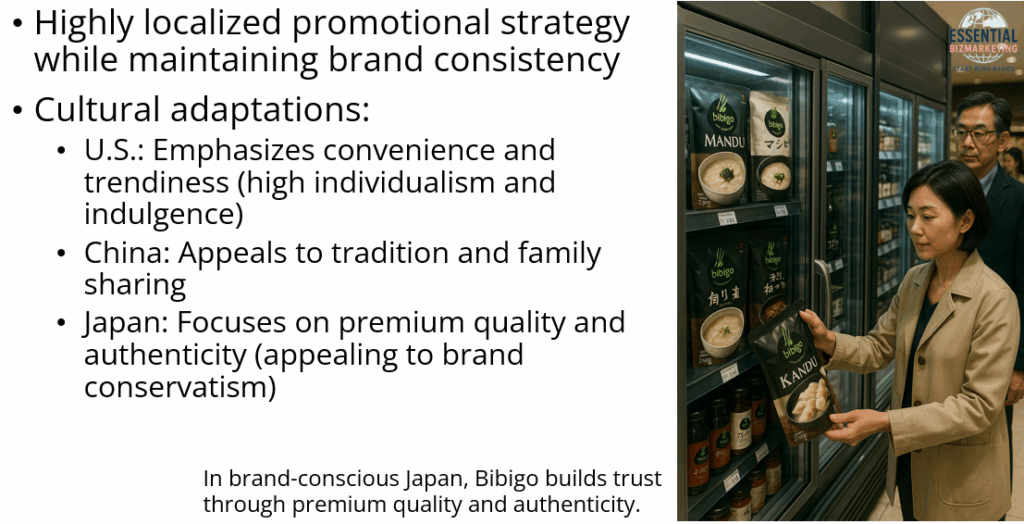
Bibigo’s promotional strategy is highly localized, using communication adaptation to ensure cultural resonance while upholding brand consistency. While the product itself remains recognizable as Korean cuisine, the messaging is customized to reflect cultural values and consumption norms in each market.
Practice 2-1 details how Bibigo tailors its messaging to local cultural dimensions. In the U.S., it emphasizes convenience and trendiness, leveraging high individualism and indulgence. In China, it appeals to tradition and family sharing. In Japan, it focuses on premium quality and authenticity to gain consumer trust in a market known for brand conservatism.
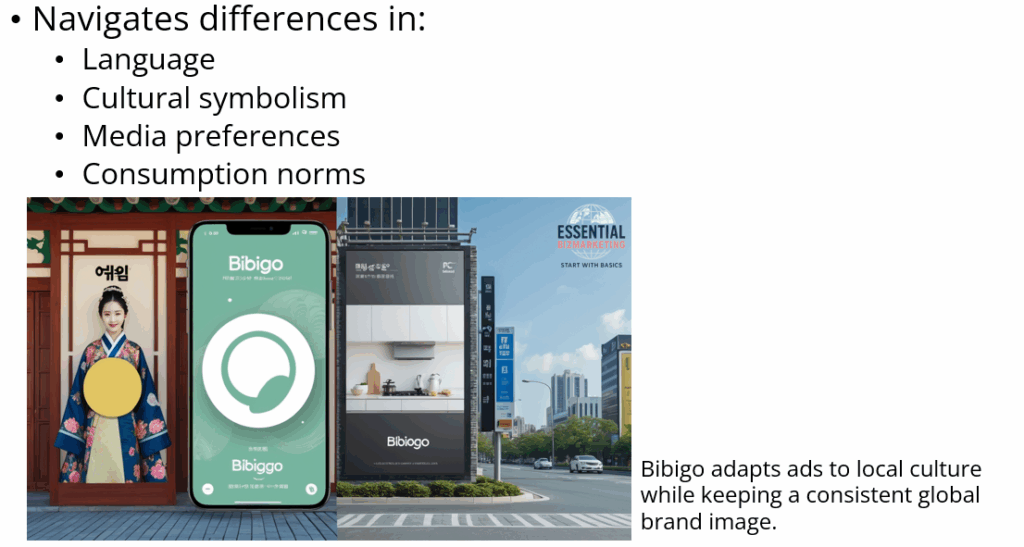
As described in Chapter 14, promotional strategies must navigate language, symbolism, and media preferences across cultures. Bibigo does so by selectively adapting advertising campaigns while maintaining a consistent global brand image.
6. Conclusion

Bibigo’s global marketing success lies in its effective orchestration of adaptation and standardization within the 4P framework. While product design and promotion are highly localized, pricing and distribution reflect economic pragmatism and infrastructural realities. This hybrid strategy enables Bibigo to remain competitive across diverse markets while reinforcing a coherent global identity.
Drawing on data and insights from the Practice materials and Chapter 14 theory, Bibigo demonstrates that a flexible, culturally aware approach to international marketing can generate both local acceptance and global brand strength.
📚 References
CJ CheilJedang. (2023, August 23). CJ CheilJedang launches new global campaign for Bibigo brand. The Korea Herald. Retrieved from https://news.koreaherald.com/view.php?ud=20230823000611news.koreaherald.com
CJ CheilJedang. (2024, February 1). New Bibigo Brand Identity for K-food Expansion. CJ Newsroom. Retrieved from https://newsroom.cj.net/new-bibigo-brand-identity-for-k-food-expansion/
CJ CheilJedang. (2024, July 26). CJ 2024 Bibigo Media Day in Paris. CJ Newsroom. Retrieved from https://newsroom.cj.net/cj-foods-drives-forward-with-bibigo-brand-at-korea-house-2024-bibigo-media-day-in-paris/
CJ CheilJedang. (2020, December 22). Bibigo mandu sets milestone in Korean food industry. KED Global. Retrieved from https://www.kedglobal.com/f-b-industry/newsView/ked202012220011Korea.net+2KED Global+2KED Global+2
CJ CheilJedang. (2023, January 15). Bibigo, K-food a success case in Harvard Business School study. KED Global. Retrieved from https://www.kedglobal.com/korean-food/newsView/ked202401150005
CJ CheilJedang. (2023, January 15). Harvard MBA school features Korean food in case study. Korea.net. Retrieved from https://www.korea.net/NewsFocus/FoodTravel/view?articleId=245515
CJ CheilJedang. (2023, January 15). CJ CheilJedang’s successful case of K-food globalization has been adopted as a case study at Harvard Business School. Maeil Business Newspaper. Retrieved from https://www.mk.co.kr/en/business/10920333
CJ CheilJedang. (2023, January 15). Due to the unrelenting popularity of K-food, Korea’s exports of ramen and other instant noodles hit a record high. Maeil Business Newspaper. Retrieved from https://www.mk.co.kr/en/business/10921324
CJ CheilJedang. (2023, October). Brands of Korea. Federation of Korean Industries. Retrieved from https://www.fki.or.kr/webzine/2410/sub_53.html
CJ CheilJedang. (2020, December). CJ – Bibigo – Business Strategy. Studocu. Retrieved from https://www.studocu.vn/vn/document/van-lang-university/social-psychology/cj-bibigo-business-strategy/23229445
📁 Start exploring the Blog
📘 Or learn more About this site
🧵 Or follow along on X (Twitter)
🔎 Looking for sharp perspectives on global trade and markets?
I recommend @GONOGO_Korea as a resource I trust and regularly learn from.
